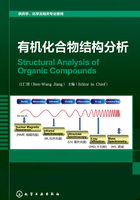
2.6 The Main Influencing Factors of the Maximum Wavelength
The UV spectrum can be influenced by conjugation effect,steric effect[97],the polarity of the solvent[98],pH of the solution[99],etc.
2.6.1 Conjugation Effect
When the molecular orbital of two isolated double bonds are brought into conjugation,the energy level of the highest occupied orbital is raised and that of the lowest unoccupied anti-bonding orbital lowered(Fig.2-5).A comparison of the absorption spectrum of ethylene,λmax=175 nm,with that of butadiene λmax=217 nm as a strong,easily detected,and easily measured maximum demonstrates the importance of chromophore conjugation.From the polyene spectra displayed in the following figure(Fig 2-6),it is clear that each additional double bond in the conjugated pi-electron system shifts the absorption maximum about 30 nm in the same direction.Also,the molar absorptivity(ε)roughly doubles with each new conjugated double bond.Thus,extending conjugation[100]generally results in bathochromic and hyperchromic shifts in absorption.

Fig.2-5 Molecular orbital of butadiene
图2-5 丁二烯的分子轨道

Fig.2-6 The sketch map of molecular orbital energy of conjugated polyene
图2-6 共轭多烯分子轨道能级示意图
When two double bonds are conjugated,the four π-atomic orbitals[101] combine to generate four pi-molecular orbitals(two are bonding and two are antibonding).In a similar manner,the three double bonds of a conjugated triene[102] create six orbitals,half bonding and half antibonding.The energetically most favorable π→π*excitation occurs from the highest energy bonding pi-orbital(HOMO)to the lowest energy antibonding pi-orbital(LUMO).When more than two π-bonding orbitals overlap,that is when the chromophore is a longer conjugated system,the separation of the energy levels is further reduced,and absorption occurs at longer wavelength.The most important point to be made is that the longer the conjugated system,the longer the wavelength of the absorption maximum in general.Many other kinds of conjugated π electron systems act as chromophores and absorb light in the 200 to 800 nm region(Pavia,et al.,Fourth Edition).
The same principle governs the energy levels when unlike chromophores,e.g.those of α,β-unsaturated ketones or aromatic ring compounds,are brought together(Fig.2-7,Fig.2-8).For instance,methyl vinyl ketone has an absorption maximum at 225nm,while neither a carbonyl group nor an isolated double bond has strong maximum above 200nm.

Fig.2-7 The molecular orbital of carbonyl and double bond conjugation
图2-7 羰基与双键共轭的分子轨道

Fig.2-8 The sketch map of new molecular orbital formed by p→π conjugation
图2-8 π体系和助色团相互作用形成新的分子轨道能级示意图
2.6.2 Steric Effect
The chromophores should achieve the effective conjugation only when they are in the same plane[103].If the chromophores are too crowded,they will be excluded from the same plane,their conjugation degree will reduce,the absorption maximum will shift to shorter wavelengths.
Two benzene rings are in the same plane in the biphenyl[104],the benzenes should produce effective conjugation,the absorption maximum(λmax)of the biphenyl is 247nm(ε 17 000).In methyl substituted biphenyl[105],with the increase of ortho substituents,two benzene rings are not in the same plane because of steric hindrance[106],so they can not effectively conjugate,the absorption maximum will shift to shorter wavelengths.

The UV spectra of cis-trans isomers[107] are obviously different.Generally,the steric hindrance of the trans isomer is small,and it can be effectively conjugated,so the absorption maximum(λmax)and the molar absorptivity(ε)of it are bigger than those of the cis isomer.

2.6.3 The Polarity of the Solvent
A nonpolar solvent[108] does not form hydrogen bond[109] with the solute,and the spectrum of the solute closely approximates the spectrum that would be produced in the gaseous state[110],in which fine structure is often observed.In a polar solvent,the hydrogen bonding forms a solute-solvent complex,and the fine structure may disappear.
The π→π* transition result in a more polar excited state than that of the ground state,the excited states may form stronger hydrogen bonds than the corresponding ground states,or the dipole-dipole interactions with solvent molecules will lower the energy of the excited state more than that of the ground state.In such a case,a polar solvent shifts an absorption to longer wavelength since the energy of the electronic transition is decreased.Thus it is usually observed that ethanol solutions give longer wavelength maxima than do hexane solutions.
The n→π* transition shows a solvent effect in the opposite direction.Polar solvents do not form hydrogen bonds as readily with the excited states of polar molecules as with their ground states,the solvent effect is now due to the lesser extent to excited state,so the polar solvents increase the energies of electronic transitions in the molecules.In hexane solution,for example,the absorption maximum of acetone is at 279 nm,where as in aqueous solution the maximum is at 264.5 nm.Polar solvents shift transitions of the n→π* type to shorter wavelengths.Fig.2-9 illustrates typical effects of a series of solvents on the different electronic transitions(Yue-Hu Pei,2015).

Fig.2-9 Effects of polarity of solvents on different electronic transitions
图2-9 溶剂极性对不同类型电子跃迁的影响
2.6.4 The pH of the Solution
In compounds that are acids or bases,pH changes can have significant effects on the absorption maximum.In phenoxide ion,there are more n electrons,and they are more available for interaction with the aromatic p system than in phenol,so the absorption maximum of phenoxide ion produces red shift.
